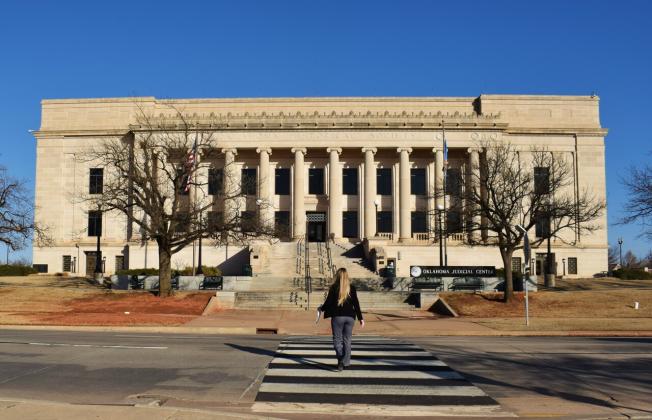OKLAHOMA CITY — A sharply divided Oklahoma Supreme Court last Tuesday ruled that a woman has an inherent right to end a pregnancy when its necessary to save her life.
Acting on a lawsuit brought by several abortion providers, Planned Parenthood and the Oklahoma Call for Reproductive Justice, the state’s high court ruled in a 5-4 decision that the Oklahoma Constitution recognizes the right of a woman to obtain an abortion when her life was in danger.
“Our history and tradition have therefore recognized a right to an abortion when it was necessary to preserve the life of the pregnant woman,” the court’s majority wrote in a 20-page opinion. “This right can be viewed as protected by the Oklahoma due process section. It can also be viewed as a right protected under the inherent rights provided in Article II, Section 2 of the Oklahoma Constitution.”
The court’s ruling, however, stopped short of addressing the issue of elective abortion.
Five justices supported the ruling: Yvonne Kauger, James Winchester, James Edmondson, Douglas Combs and Noma Gurich. Those in opposition included Chief Justice John Kane IV, Vice Chief Justice Dustin Rowe and Justices Richard Darby and Dana Kuehn.
The ruling generated complaints from the Republican-controlled Oklahoma Legislature and Gov. Kevin Stitt. The ruling also sparked five separately published opinions in both support and opposition.
In a media statement issued after the court published its ruling, Stitt said he wholeheartedly disagreed with the court’s ruling.
“Alarmingly, this activist majority acted out of hand by making a policy decision that belongs to the people,” the governor’s statement read. “Chief Justice Kane said it best in his well-written dissent: ‘This Court should adhere to the Constitution given to us, not craft what we believe to be a “better” Constitution. The power lies with the people.’”
Stitt also complained that the court’s 20-page opinion didn’t mention the unborn.
“From the moment life begins at conception, we have a responsibility to do everything we can to protect that baby’s life and the life of the mother,” the governor said. “That is what I believe and that is what the majority of Oklahomans believe which is why the Legislature has passed, and I have signed, numerous laws banning abortion in Oklahoma.”
While some state district courts have previously upheld a right to abortion based in part on the U.S. Supreme Court’s Roe v. Wade ruling, after the case was overturned last year activists on both sides of the abortion issue have sought relief in state courts.
In Oklahoma, reproductive rights activists pointed to the Oklahoma Constitution saying it supported abortion rights. Oklahoma’s high court, however, narrowed that argument. It said the state constitution only protected abortion when a woman’s life was in danger.
Writing on the issue of how the elimination of Roe v. Wade pushed the abortion issue back to the states, Oklahoma’s high court wrote that the U.S. Supreme Court “found that a state may enact regulations, as it can with any other medical procedure to further the health or safety of a woman seeking an abortion. However, unnecessary health regulations that have the purpose of presenting a substantial obstacle to a woman seeking an abortion (pre-viability) impose an undue burden on the right.”
That right, the majority wrote, has existed in state law since statehood. While many Oklahoma law have prevented elective abortion, the court said, that was only half the story of Oklahoma.
“The law in Oklahoma has long recognized a woman’s right to obtain an abortion in order to preserve her life,” the majority wrote. “Our history and tradition have therefore recognized a woman’s right to obtain an abortion when it was necessary to preserve the life of the pregnant woman. This right can be viewed as protected by the Oklahoma due process section. It can also be viewed as a right protected under the inherent rights provided in Article II, Section 2 of the Oklahoma Constitution.”
In his dissent Chief Justice Kane wrote that the majority “engages in legal contortions to protect pregnant women who are in medical peril by fashioning Oklahoma Constitutional precepts of abortion that simply do not exist.
“There is no expressed or implied right to abortion enshrined in the Oklahoma Constitution,” he wrote. “In interpreting our Constitution, this court must guard against the innate human temptation to confuse what is provided in the Oklahoma Constitution with what one wishes were provided.”
Echoing Kane, Justice Rowe wrote that the state’s high court has studiously avoided addressing the question of whether the Oklahoma Constitution protects a right to abortion, despite having been presented with numerous opportunities to do so.
“In the light of the court’s track record of diligently avoiding these issues, it is difficult to understand why now the majority believes ‘there is a pressing need to rule on this matter as soon as possible,’” Rowe wrote. “Now, rather than allowing the democratic process to play out in Oklahoma, the majority has imposed its own policy preference upon the people of our state.”
Justice Kauger, who has served on the high court for 39 years, said history was on the side of the woman. In a 33-page opinion concurring with the majority, Kauger pointed to statutes from both the Oklahoma Territorial Legislature and the Indian Territorial Legislature as examples of language that carved out an exemption for a woman whose life was in danger.
“In territorial days, and statutorily at statehood, the law preserved this right,” Kauger wrote. “Obviously the framers of the Constitution took this into account when they unambiguously guaranteed the inherent rights of life, liberty and the pursuit of happiness. There was not an exception carved out of the statutes or the constitution requiring a medical emergency. The law provided the right to terminate a pregnancy was available to preserve the life of the mother – period.”


